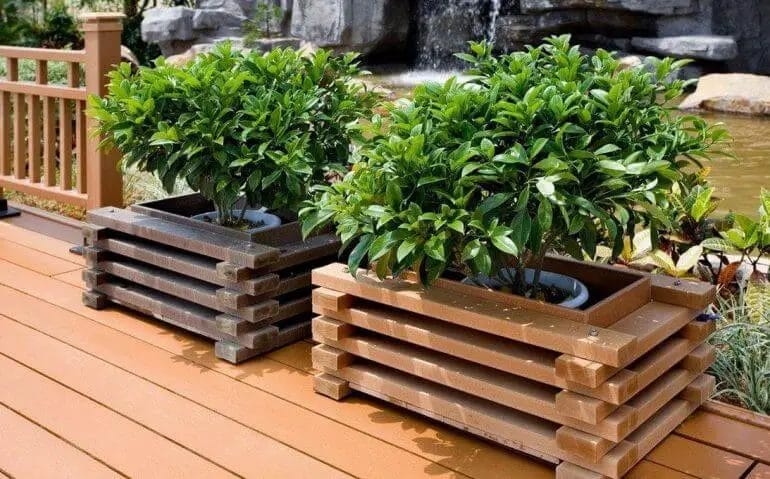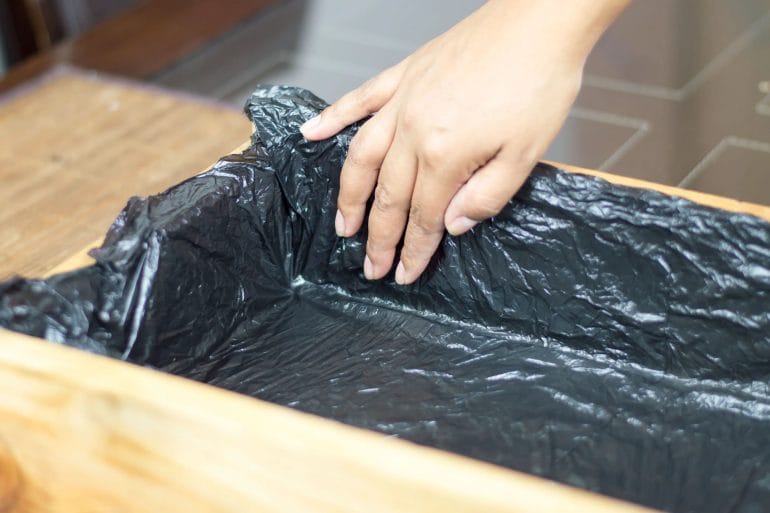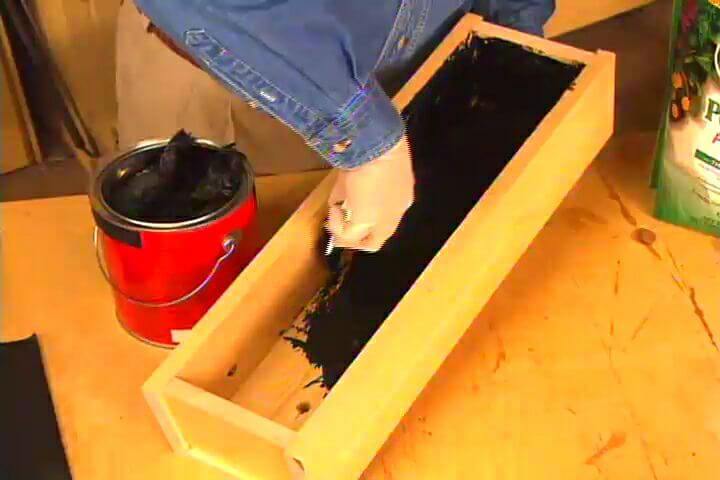If you’re looking to protect your wooden planter box from moisture damage and extend its lifespan, waterproofing is essential. By applying a waterproof sealant or liner to the inside, you can prevent water penetration, rot, and decay. Additionally, waterproofing helps maintain the integrity of the wood, ensuring its durability in various weather conditions. In this guide, we’ll explore different methods of waterproofing the inside of a wood planter box, providing you with the knowledge to preserve your planter and keep your plants thriving.

Choosing the Right Waterproofing Materials for Your Wood Planter Box
When it comes to creating a beautiful garden space, wooden planter boxes can add a touch of elegance and charm. However, without proper waterproofing, these boxes can quickly deteriorate and lose their appeal. To ensure the longevity of your wood planter box, it is essential to choose the right waterproofing materials. In this section, we will explore some options that can effectively protect your planter box from water damage.

1. Liners
One of the most common and easiest ways to waterproof your wooden planter box is by using liners. Liners act as a barrier between the wood and the soil, preventing direct contact and potential water damage. There are various liner materials available, such as plastic, rubber, or even fiberglass. Plastic liners are affordable and readily available, while rubber liners offer increased durability and flexibility. Fiberglass liners provide excellent water resistance but may require professional installation.
2. Membrane Coatings
Another effective method to waterproof your wood planter box is by using membrane coatings. These coatings create a protective layer on the wood surface, preventing water from seeping in. There are two primary types of membrane coatings: liquid and sheet. Liquid membrane coatings are easy to apply and can be brushed or sprayed onto the wood. Sheet membranes, on the other hand, are pre-cut to fit the dimensions of your planter box and require adhesive to secure them in place.
3. Sealants and Paints
Sealants and paints can also provide an additional layer of waterproofing for your wooden planter box. Sealants, such as polyurethane or epoxy, penetrate the wood fibers and create a protective barrier against moisture. Paints, specifically exterior-grade latex or oil-based paints, can also offer waterproofing properties while adding color and style to your planter box. Make sure to choose a paint or sealant that is specifically designed for outdoor use and is compatible with wood surfaces.
4. Natural Oils and Waxes
If you prefer a more natural approach, you can consider using oils and waxes to waterproof your wooden planter box. Natural oils, such as linseed oil or tung oil, penetrate the wood and provide moisture resistance. Beeswax and carnauba wax can also be applied to the surface of the wood, creating a protective barrier against water. However, it is important to note that natural oils and waxes may require regular reapplication to maintain their effectiveness.
5. Drainage System
In addition to the waterproofing materials mentioned above, incorporating a drainage system into your wooden planter box is crucial. Proper drainage allows excess water to escape, preventing waterlogged soil and potential damage to the wood. You can achieve this by drilling or cutting drainage holes at the bottom of the planter box and adding a layer of gravel or pebbles to facilitate water flow.
In summary, choosing the right waterproofing materials for your wood planter box is essential to ensure its longevity and protect it from water damage. Whether you opt for liners, membrane coatings, sealants, natural oils, or a combination of these methods, it is crucial to consider the specific needs of your planter box and the environmental conditions it will be exposed to. By taking the time to properly waterproof your wooden planter box, you can enjoy a beautiful and durable addition to your garden for years to come.

Step-by-step guide to waterproofing the inside of a wood planter box
If you love gardening and enjoy growing plants in wooden planter boxes, it’s important to ensure that the wood is properly waterproofed. Waterproofing helps protect the wood from rot, decay, and water damage, ensuring the longevity of your planter box. In this section, we will provide a step-by-step guide to help you effectively waterproof the inside of a wood planter box.
Gather the necessary materials
Before you begin the waterproofing process, it’s important to gather all the necessary materials. Here’s a list of items you’ll need:
- Wood planter box
- Waterproofing sealant or paint
- Paintbrush or roller
- Sandpaper
- Cloth or sponge
Prepare the planter box
The first step is to prepare the planter box for waterproofing. Start by removing any plants, soil, or debris from the box. Clean the inside of the box using a cloth or sponge to ensure that it’s free from dirt and dust. If there are any rough or uneven surfaces, sand them down using sandpaper to create a smooth surface for the waterproofing material.
Apply the waterproofing sealant
Once the planter box is clean and smooth, it’s time to apply the waterproofing sealant. You have two options for this step: using a waterproofing sealant or using waterproofing paint.
If you choose to use a sealant, start by stirring it well to ensure it’s properly mixed. Use a paintbrush or roller to apply a thin and even coat of sealant to the inside of the planter box. Make sure to cover all surfaces, including the corners and edges. Allow the first coat to dry completely before applying a second coat if needed. Follow the manufacturer’s instructions for drying times between coats.
If you prefer to use waterproofing paint, follow the same process as with the sealant. Use a paintbrush or roller to apply a thin and even coat of paint to the inside of the planter box. Again, make sure to cover all surfaces and allow each coat to dry completely before applying additional coats if necessary.
Let it cure
After applying the waterproofing sealant or paint, it’s essential to let it cure properly. Follow the manufacturer’s instructions for the recommended curing time. During this time, avoid placing any plants or soil inside the planter box to allow the sealant or paint to fully dry and create a protective barrier.
Test for waterproofing
Once the curing time is complete, it’s a good idea to test the effectiveness of the waterproofing. Pour a small amount of water into the planter box and observe if any leakage occurs. If there are no signs of water leakage, your planter box is successfully waterproofed. However, if you notice any leaks, you may need to apply an additional coat of sealant or paint to ensure complete waterproofing.
In summary, waterproofing the inside of a wood planter box is a crucial step in maintaining its durability and preventing water damage. By following this step-by-step guide, you can effectively waterproof your planter box and enjoy gardening without worrying about rot or decay caused by moisture.

Tips for maintaining the waterproofing of your wood planter box
If you have a wood planter box, it is important to properly maintain its waterproofing to ensure its longevity and protect your plants. Wood is a natural material that can be susceptible to water damage if not properly treated and maintained. In this section, we will discuss some useful tips for maintaining the waterproofing of your wood planter box.
Choose the right type of wood
When selecting the wood for your planter box, it is important to choose a type that is naturally resistant to water damage. Some popular choices include cedar, redwood, and teak. These types of wood have natural oils and resins that help repel water and prevent rot.
Apply a waterproof sealant
Before using your wood planter box, it is essential to apply a waterproof sealant to protect the wood from moisture. There are various types of sealants available, such as polyurethane, linseed oil, or a water-based sealant. Make sure to follow the manufacturer’s instructions for application and allow the sealant to fully dry before using the planter box.
Regularly inspect for damage
It is important to regularly inspect your wood planter box for any signs of damage or wear. Check for any cracks, warping, or peeling of the sealant. If you notice any issues, address them promptly to prevent further damage. Repair any cracks or replace damaged boards to maintain the waterproofing.
Consider a liner
To provide an extra layer of protection, you can consider using a liner inside your wood planter box. Liners can be made of plastic or a waterproof fabric material. They help prevent direct contact between the soil and the wood, reducing the risk of water damage and extending the lifespan of your planter box.
Proper drainage
Ensure that your wood planter box has proper drainage to prevent water from pooling and causing damage. Drill drainage holes in the bottom of the box to allow excess water to escape. Additionally, place a layer of gravel or small stones at the bottom of the planter box to facilitate drainage.
Regular cleaning
Regularly clean your wood planter box to remove any dirt, debris, or mold that may accumulate over time. Use a mild detergent or a mixture of water and vinegar to gently scrub the surface. Avoid using harsh chemicals or abrasive cleaners that can damage the wood or the waterproof sealant.
Protect from extreme weather
Extreme weather conditions, such as heavy rain or intense sunlight, can accelerate the deterioration of your wood planter box. Consider moving the planter box to a sheltered area during harsh weather or use a protective cover to shield it from the elements. This will help prolong the lifespan of the waterproofing.
Reapply sealant as needed
Over time, the waterproof sealant on your wood planter box may wear off. It is essential to reapply the sealant periodically to maintain the waterproofing. The frequency of reapplication will depend on various factors such as the type of sealant used, weather conditions, and the overall wear and tear of the planter box.
In summary, by following these tips for maintaining the waterproofing of your wood planter box, you can ensure its longevity and keep your plants healthy. Remember to choose the right type of wood, apply a waterproof sealant, regularly inspect for damage, consider using a liner, ensure proper drainage, clean the planter box regularly, protect it from extreme weather, and reapply sealant as needed. With proper maintenance, your wood planter box will continue to enhance your garden for years to come.
Creative Ideas for Decorating and Styling Your Waterproofed Wood Planter Box
Are you looking for ways to decorate and style your waterproofed wood planter box? Look no further! In this section, we will explore some creative ideas that will transform your planter box into a stunning focal point for your garden or outdoor space.
1. Paint and Stain
One of the easiest ways to add a personal touch to your planter box is by painting or staining it. Choose a color that complements your existing outdoor decor or opt for a bold and vibrant hue to make a statement. You can also consider using a combination of colors to create a unique and eye-catching design.
Staining your planter box allows the natural beauty of the wood to shine through while adding a protective layer. Choose a stain that enhances the grain and texture of the wood, such as a warm cedar or rich mahogany tone.
2. Add Decorative Hardware
Enhance the look of your planter box by adding decorative hardware. Consider attaching metal corner brackets or decorative handles to give it a touch of elegance and sophistication. Additionally, you can use decorative screws or nails to add visual interest and create a unique design.
3. Incorporate Trellises or Lattice
If you want to add height and vertical interest to your planter box, consider incorporating trellises or lattice. These structures provide support for climbing plants and add a charming and whimsical touch to your outdoor space. You can place the trellises or lattice at the back of the planter box and train vines or flowers to grow on them.
4. Personalize with Engraving
Add a personal touch to your planter box by engraving it with your initials, a meaningful quote, or a special date. This customization not only adds a unique and personalized touch but also makes your planter box a conversation starter.
5. Mix and Match Plants
Create visual interest and variety by mixing and matching different types of plants in your planter box. Combine tall and trailing plants, colorful blooms, and different foliage textures to create a visually stunning arrangement. Consider using a combination of annuals and perennials to ensure year-round color and beauty.
6. Incorporate Decorative Elements
Add decorative elements to your planter box to enhance its overall appeal. Consider adding decorative rocks or pebbles to the bottom for drainage, or incorporate seashells, driftwood, or ornaments for a beachy or nautical theme. You can also add decorative moss, twigs, or fairy lights for a whimsical touch.
7. Create a Herb or Vegetable Garden
Transform your planter box into a functional and beautiful herb or vegetable garden. Choose a variety of herbs or vegetables that you enjoy cooking with or ones that add color and texture to your outdoor space. Not only will you have fresh ingredients at your fingertips, but you’ll also have a visually appealing and fragrant addition to your garden.
8. Incorporate Water Features
Add a touch of tranquility to your planter box by incorporating a small water feature. Consider adding a mini fountain or a small pond with floating plants. The gentle sound of water and the movement of the aquatic plants will create a soothing and calming atmosphere in your garden.
With these creative ideas, you can transform your waterproofed wood planter box into a stunning and unique centerpiece for your garden or outdoor space. Let your imagination run wild and enjoy the process of decorating and styling your planter box to reflect your personal style and taste.
FAQs
1. How can I waterproof the inside of a wood planter box?
To waterproof the inside of a wood planter box, you can use a waterproof sealant or liner. Apply a waterproof sealant to the interior surfaces of the box, making sure to cover all the edges and corners. Alternatively, you can line the inside of the box with a plastic liner or a waterproof membrane to prevent water from seeping into the wood.
2. What are the benefits of waterproofing a wood planter box?
Waterproofing a wood planter box helps to prolong its lifespan by protecting the wood from moisture, rot, and decay. It prevents water from seeping into the wood, which can cause it to warp or deteriorate over time. Additionally, waterproofing helps to maintain the appearance of the planter box and prevents any potential water damage to the surrounding areas.
3. Can I use any type of sealant to waterproof a wood planter box?
It is recommended to use a sealant specifically designed for wood, such as a wood sealant, wood stain, or exterior-grade waterproofing sealant. These products are formulated to provide protection against moisture and UV rays, ensuring long-lasting waterproofing for your wood planter box. Be sure to follow the manufacturer’s instructions for application and reapplication if necessary.
Conclusion
In conclusion, waterproofing the inside of a wood planter box is a vital step to ensure the longevity and durability of the box. By applying a waterproof sealant or liner, you can protect the wood from moisture damage, rot, and decay. Additionally, this process will also prevent leakage and prevent water from seeping out of the box, making it suitable for a variety of indoor and outdoor settings.
Remember, when waterproofing your wood planter box, it is important to choose a non-toxic and eco-friendly option to ensure the safety of your plants and the environment. Regular maintenance and reapplication of the waterproofing treatment will help prolong the lifespan of your planter box and keep it looking beautiful for years to come.
